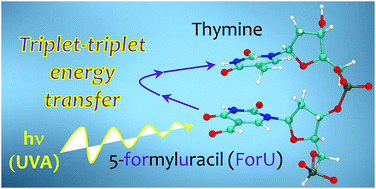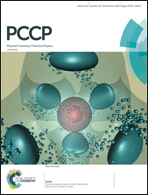Triplet photosensitization mechanism of thymine by an oxidized nucleobase: from a dimeric model to DNA environment†
Abstract
Nucleic acids are constantly exposed to external agents that can induce chemical and photochemical damage. In spite of the great advances achieved in the last years, some molecular mechanisms of DNA damage are not completely understood yet. A recent experimental report (I. Aparici-Espert et al., ACS Chem. Biol. 2018, 13, 542) proved the ability of 5-formyluracil (ForU), a common oxidatively generated product of thymine, to act as an intrinsic sensitizer of nucleic acids, causing single strand breaks and cyclobutane pyrimidine dimers in plasmid DNA. In the present contribution, we use theoretical methodologies to study the triplet photosensitization mechanism of thymine exerted by ForU in a model dimer and in DNA environment. The photochemical pathways in the former system are described combining the CASPT2 and TD-DFT methods, whereas molecular dynamics simulations and QM/MM calculations are employed for the DNA duplex. It is unambiguously shown that the 1n,π* state localised in ForU mediates the population of the triplet manifold, most likely the 3π,π* state centred in ForU, whereas the 3π,π* state localized in thymine can be populated via triplet–triplet energy transfer given the small energy barrier of <0.23 eV determined for this pathway.

- This article is part of the themed collection: 2018 PCCP HOT Articles


 Please wait while we load your content...
Please wait while we load your content...